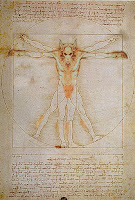Before UCLA, I was torn between majoring in architecture or civil engineering. The artistic complexity of architecture is very impressive, but I am a science guy and I gravitate more towards the numbers. As nerdy as this sounds, the first time I realized how mathematically complex architecture truly is was when I watched a Harry Potter movie. Specifically the scene that showed the transformation of a werewolf during a full moon. In order to show the proportions of the werewolf, they used Leonardo Da Vinci's Vitruvian Man. As Vesna states, math has not only influenced art itself, but it also has influenced popular culture.
In "The Fourth Dimension and Non-Euclidean Geometry in Modern Art", Henderson states that "we [artists] are motivated by a desire to complete our subjective experience by inventing new aesthetic and conceptual capabilities." Leonardo Da Vinci has done just that with his idea of human proportionality that has revolutionized the techniques of geometric art. Da Vinci's Vitruvian Man has also influenced the contemporary architects with the idea of human proportions. The golden ratio is said to be the most aesthetically pleasing proportion in many works of art. Le Corbusier's Modular System that utilizes the golden ratio is one of most renowned systems in modern architectural scales and proportions.
By using techniques such as line perspective and vanishing point that are derived from geometry and other mathematical concepts, artists have learned to express themselves in a different point of view. Also, by using geometric shapes and primary colors, artists can express nature and logic in innovative ways. Mathematics and art may seem very independent each other. However, throughout history, these two have always complemented each other and have continued to find more innovative ways to collaborate.
Sources:
Henderson,
Linda D. "The Fourth Dimension and Non-Euclidean Geometry in Modern
Art." Leonardo17.3 (1984):
209. Jstor. Web.
"Mathematical
Masterpieces: Marking Art From Equations." Discover Magazine. N.p., 28
Feb. 2014. Web.
SuperSheikGeek.
"Vitruvian Werewolf Original de." On DeviantArt. N.p., n.d.
Web.
Vesna,
Victoria. "Mathematics pt1." Zero Perspective Golden Mean. 16 Apr.
2017. Lecture.
"What
does “Vitruvian” Mean Anyway?" Vitruvian Fine Art Studio. N.p., n.d.
Web.




Comments
Post a Comment